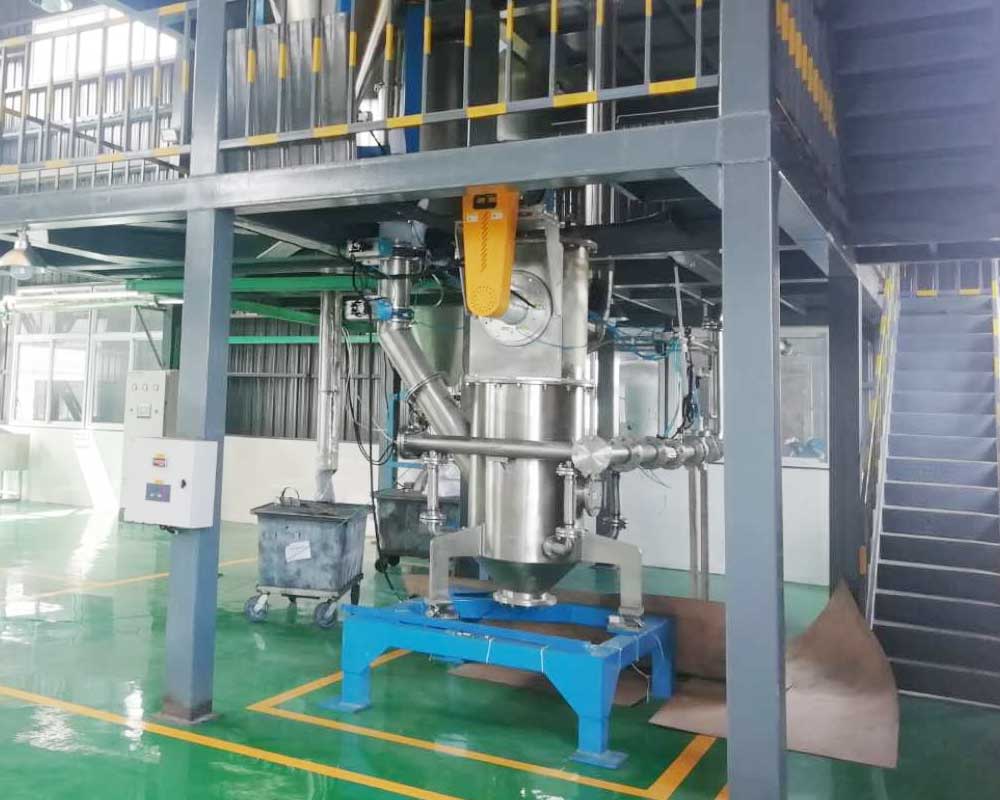Jet mill has outstanding advantages for processing ternary cathode materials
Generally speaking, there are basically two kinds of ternary cathode materials, one is nickel cobalt lithium aluminate NCA and the other is nickel cobalt manganese lithium NCM. The main purpose is to use in ternary cathode material batteries.
In the processing of ternary materials, the main steps are in three aspects. The first is: mixed abrasives, the second is: high temperature sintering, and the third is: crushing and decomposition. The material particles can be pulverized by a purchased jet pulverizing classifier to achieve the appropriate particle size requirements, and then sieved through classification to obtain the desired ideal particles of ternary materials. The ideal particle is usually around 42μm, and the fluctuation cannot exceed 6μm. This kind of particle can be processed by a jet mill.
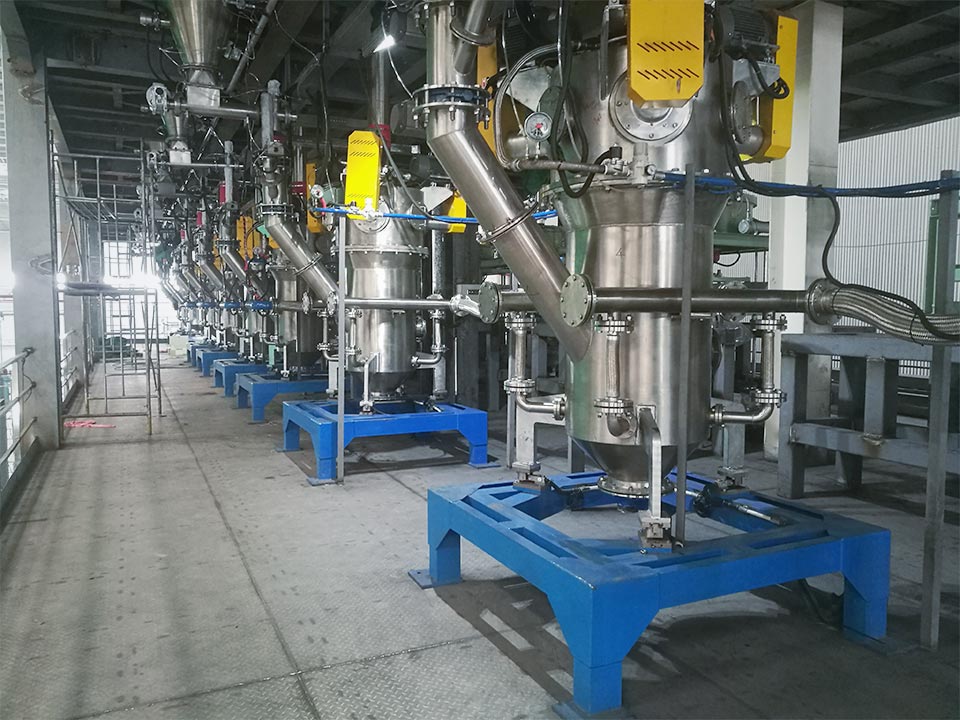
The jet mill has outstanding advantages for processing ternary cathode materials, and its performance lies in:
- It has the ability to shape the particles and control the particle size. The finished particles have excellent shape and can be used for different material characteristics and requirements.
- The material distribution is narrow, and the finished product has a high tap density.
- Over-grinding is low, and the finished product rate can reach over 96%.
- The equipment is lined with wear-resistant materials, the equipment wears little, and the finished product has high purity.
- Using frequency converter for precise control, the material fineness can be adjusted arbitrarily between 0.5-100 μm.
- Full negative pressure operation, low noise, no dust pollution.
The jet mill used to crush ternary materials has a built-in high-precision turbine classification system, which can accurately separate the specified particle size after crushing, and the whole machine adopts closed-circuit operation to effectively prevent dust pollution.
Application of powder materials in different kinds of coatings
1. Application of powder materials in coatings
1) Extender pigments (heavy calcium, light calcium, kaolin, etc.) can improve the "dry hiding power" effect of latex coatings, replacing part of the amount of titanium dioxide used (called contrast ratio or hiding ratio) to reduce manufacturing costs.
2) Application of wollastonite powder in intumescent latex fireproof coating
In fire retardant latex coatings, fire retardants and emulsions are important for fire resistance. Although the proportion of fillers used in fire retardant latex coatings is not large, wollastonite, aluminum hydroxide and hollow microspheres are used as fillers in fire retardant latex coatings to account for 5%, 2% and 4%. Among them, wollastonite plays the role of the skeleton of the coating film, aluminum hydroxide plays the role of flame retardant, smoke suppression and cooling, and the air beads play the role of carbon layer strength.
Kaolin and wollastonite with the same fireproof effect of the carbon layer have high expansion, the highest is wollastonite, followed by kaolin, and the lowest time sequence of talc powder is wollastonite>kaolin>talc powder, which means that when the carbon layer reaches a honeycomb shape, The higher the expansion height, the better the heat insulation and fire protection effect. Of course, the carbon layer should not be too high, otherwise it will cause the separation between the carbon layer and the steel plate, which will not play the role of fire prevention. The coating containing Al(OH)3 has the least amount of smoke, especially the longest fire resistance time, and is a very good flame retardant additive.
The order of comparing the five inorganic fillers is: Al(OH)3 >wollastonite>kaolin>talc>CaCO3, so it is the most ideal to use Al(OH)3 as a flame retardant with wollastonite. In the formula, silica fume Stone 5%, Al(OH)3 2% is the most ideal filler layer, with the longest fire resistance time and the least amount of smoke.
3) Application of sericite (muscovite) in latex paints for exterior walls of buildings
Sericite silicate flakes have a strong extinction shielding function, can absorb more than 80% of ultraviolet rays, close to the ultraviolet absorption rate of titanium dioxide, good wear resistance, insulation, good chemical stability, acid and alkali resistance, Water permeability. When adding 5% to latex paint for exterior walls, it can improve the weather resistance of the coating, delay the chalking, discoloration and cracking of the coating, and increase the hardness and toughness of the coating film. A 600-hour artificial aging test was carried out on the latex coating containing Ca4 wet sericite and the latex coating. The aging performance and appearance have been improved from blistering and peeling to non-foaming peeling and no cracking, and the discoloration has changed from level 2 to level 1. Chalking changes from level 3 to level 0 (no chalking), but sericite is not suitable for the obvious matting effect of high-gloss exterior wall latex paint on the paint.
2. The role of powder materials in coatings
Powder materials for coatings include extender pigments, anti-rust pigments, coloring pigments, special pigments, and functional pigments. Among them, extender pigments are a major branch of the powder particle system. Due to the particle size, particle shape, oil absorption, density characteristics of the extender pigment, or the unique characteristics after modification, it has a certain effect and influence on the coating. Especially ultra-fine powder materials until nano-scale materials have a more obvious effect on coatings, and roughly have the following effects:
1) The hiding power of the pigment can be used efficiently
2) The solid content of the paint can be increased, and the limit of harmful volatile organic compounds (VOC) in the paint can be controlled.
3) It can improve the scrubbing resistance of the coating and control the gloss of the coating
4) It can control the sedimentation of the coating system and increase the tensile strength of the coating film.
5) It can adjust the viscosity of the coating system and improve the adhesion of the coating
6) It can improve the abrasion resistance and slip resistance of the coating
7) When the pigment physique concentration in the coating formulation is less than the critical pigment physique concentration, the dry covering power of the coating film can be improved
8) Can be used as a reinforcement and extender for coatings
9) It can improve the stain resistance and corrosion resistance of the coating.
10) A buffering agent that can control the pH of water-based latex coatings
11) It can improve the hand feel of the coating and the hardness of the coating when it feels wet and dry. Extender pigments are not only used as fillers to reduce the cost of coating manufacturing, but also specially processed extender pigments play a role in improving the performance and function of the coating.
Article source: China Powder Network
Factors affecting the production efficiency of fluidized bed jet mill
The fluidized bed jet mill, in the dry mill, has a simple structure and can realize continuous feeding and discharging. It will neither make the material too fine nor too thick. Only materials of qualified size can be used. It is delivered continuously and timely, and its particle size distribution is steep.
Due to the crushing principle of this model, a specially designed nozzle generates a supersonic high-speed airflow. Under the acceleration of the supersonic airflow, the materials to be crushed collide, squeeze and rub against each other and are instantly crushed at the intersection of the nozzles. Since the material does not violently collide with internal parts such as the vessel wall, the equipment is durable and more importantly, it ensures the high purity of the material after crushing. Another important feature is that the gas ejected from the nozzle forms adiabatic expansion in the crushing chamber, and the temperature of the material will not rise during the crushing process. On the contrary, the material is pulverized instantly at low temperature. This pulverization method can pulverize heat-sensitive materials without adding additional refrigerant, and it can also ensure that its physical and chemical properties remain unchanged.
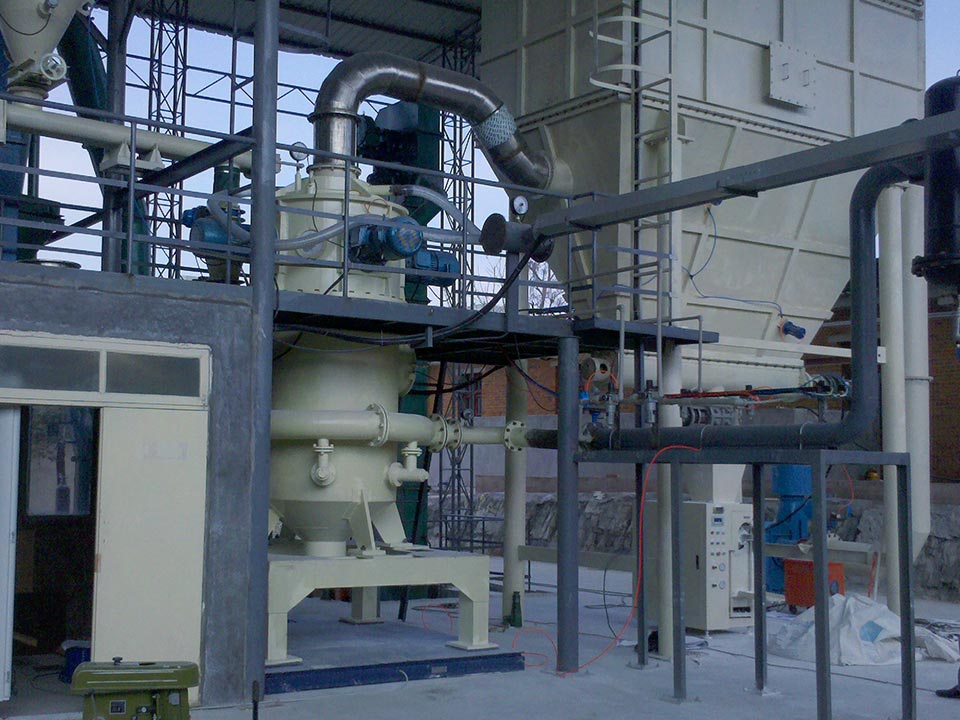
However, the energy consumption per unit output of the fluidized bed jet mill is relatively high. Although this model has many advantages, it still seems to be overburdened for products with low added value.
Nevertheless, people still place great enthusiasm and expectations on the fluidized bed jet mill. Some scholars believe that if the working efficiency of the fluidized bed airflow ultrafine pulverizer can be increased by 1 to 2 times, it will be a very meaningful thing. Due to the improved working efficiency of this model, it will open up a wider range of applications. prospect.
In our long-term experience in the research, development and use of fluidized bed jet mills, we have accumulated a certain amount of practical experience.
If you want to improve the working efficiency of the jet mill, you should first consider two parts, that is, the mill itself and its operating conditions.
(1) Strictly control the feed volume: the feed speed should be appropriate and uniform. In addition, we must also consider which feeding method to use. Some materials need to use a screw feeder, and some materials need to be oscillated. The feeding method should be determined according to the characteristics of the material itself. The most important thing is to ensure that the energy in the crushing room is continuously supplied with materials to meet a certain concentration of materials in the crushing room. Practice has proved that whether the material concentration is too low or the material concentration is too high, it will have an adverse effect on the output of the finished product. The material concentration is low, the probability of contact between materials is small; the material concentration is high, which will affect the airflow speed, both of which are not conducive to the improvement of efficiency. The feed rate of the material should be strictly controlled according to the air pressure, material characteristics and the characteristics of the body itself.
(2) Increase the air velocity and the probability of particle impact. This must be agreed from two aspects. First of all, the nozzle design must be reasonable, and the nozzle layout is also very important. Only by meeting the above two requirements can the goal of improving production efficiency be achieved.
The jet mill breaks the traditional mode of setting nozzles. In the same plane of the crushing chamber, it forms a certain angle with this plane, and several nozzles are arranged symmetrically downwards. In addition, at the bottom of the crushing chamber, the opposite is set A vertically upward nozzle, and the center line of the other nozzles, point to the same focal point. Under the combined action of the air currents ejected from all nozzles, the materials form a conical shape and gather at the focal point, and the materials are instantly crushed. In addition, a mixing tube is installed in front of the nozzle, so that there is no blind zone in the crushing chamber, and the impact probability of particles is increased. Only this modification can increase the efficiency by 150-200%.
(3) Optimize the hierarchical structure. Classification is a crucial part of the ultrafine pulverization system. One of the most notable features of the fluidized bed jet mill is that it can realize continuous feeding and discharging, preventing the material from being finely crushed and causing unnecessary energy consumption. According to the principle of turbine classification, appropriately increasing the diameter of the classifying wheel, increasing the speed, and reducing the air flow are the fundamental guarantees to ensure that the classifier separates the particle size. The relationship between the above three should be controlled according to the characteristics and specific requirements of different materials.
(4) The original material entering the jet mill should be as small as possible. In order to achieve this goal, an ordinary grinder should be used for pre-crushing treatment before ultra-fine pulverization. This is the most direct and effective method to save energy and increase unit output.
(5) Ensure that the fluidized bed jet mill, the airtightness requirements of the entire closed system, including the fully enclosed devices of pipelines, valves, and equipment, should not leak. In short, it is necessary to concentrate precious aerodynamic energy on the nozzles, and strive to increase the gas flow rate and pressure.
(6) The product collection and dust collector should ensure smooth air supply and should not have excessive resistance. This part of the system equipment must not only ensure the collection of qualified products, but also ensure that the environmental requirements are not polluted, but after the equipment is too complicated, things will bring too much burden to the overall work.
Application of calcium carbonate in coatings
Calcium carbonate is a non-toxic, odorless, non-irritating white powder, and it is one of the most widely used inorganic fillers. Calcium carbonate is neutral, basically insoluble in water but soluble in acid. According to the different production methods of calcium carbonate, calcium carbonate can be divided into heavy calcium carbonate, light calcium carbonate, colloidal calcium carbonate and crystalline calcium carbonate.
Calcium carbonate is a common substance on earth. It exists in aragonite, calcite, chalk, limestone, marble, travertine and other rocks. It is also the main component of animal bones or shells. Calcium carbonate is an important building material and has a wide range of industrial uses.

1 Application in latex paint
1.1 The role of heavy calcium
(1) As an extender pigment, it has a filling effect to make it fine, uniform and high whiteness.
(2) It has a certain degree of dry covering power. Generally, ultra-fine products are used. When the particle size is close to that of the titanium dioxide, the covering effect of the titanium dioxide can be improved.
(3) It can improve the strength, water resistance, dryness and scrub resistance of the paint film.
(4) Improve color retention.
(5) Reduce costs and use 10%~50%. Disadvantages: high density, easy to precipitate, the usage amount should not be too large.
1.2 The role of light calcium
(1) As an extender pigment, it has a filling effect, is delicate, and increases whiteness.
(2) Has a certain dry covering power.
(3) The density is small, the specific surface area is large, and it has a certain degree of suspension, which plays a role of anti-settling.
(4) Reduce costs.
(5) Increase the feel. Disadvantages: easy to whiten, swell and thicken, the usage amount should not be too large, and it can not be used in exterior wall coatings.
2 Application in powder coatings
(1) It can be used as a filler for high-gloss coating products.
(2) Semi-gloss paint products can generally be prepared by directly adding calcium carbonate without adding matting agents, which saves costs.
(3) It is a white inorganic pigment that can be used in conjunction with titanium dioxide to reduce costs.
(4) Compared with other fillers, calcium carbonate is most suitable for some environmentally friendly products that require low heavy metal content, such as children's toys and strollers.
(5) It can increase the powdering rate and spraying area of the paint, especially when it is used in mixed powder.
(6) If outdoor weather resistance is required, it cannot be used as a filler.
(7) Because of its high oil absorption, it is easy to cause orange peel on the surface of the paint film. At this time, a little hydrogenated castor oil can be added to the base material.
(8) It acts as a skeleton to increase the thickness of the paint film and improve the wear resistance and durability of the coating.
3 Application in wood coatings
(1) Used as a filler for colored primers to reduce costs.
(2) Increase paint film strength and wear resistance.
(3) Light calcium has a little thickening effect, is easy to thixotropy, and has good anti-settling properties.
(4) Heavy calcium reduces the sandability in the paint film and is easy to precipitate in the tank, so attention should be paid to strengthen the anti-settling property.
(5) Improve the gloss, dryness and whitening of the paint film.
(6) It is not suitable to use with alkali-resistant pigments and fillers.
4 Application in automotive paint
Superfine calcium carbonate with a particle size of less than 80nm is used in car chassis anti-stone coatings and topcoats due to its good thixotropy. The market capacity is 7000~8000 t/a, and the price in the international market is as high as US$1100~1,200 /t.
5 Application in ink
Ultra-fine calcium carbonate is used in ink, showing excellent dispersibility, transparency, excellent gloss and hiding power, as well as excellent ink absorption and drying. It must undergo activation treatment, and the crystal form is spherical or cubic.
Article source: China Powder Network
Ceramic lined jet mill solves the problem of material adhesion
Because of their special material properties, some materials may adhere during the crushing process, which may cause blockage or agglomeration, which brings considerable trouble to the crushing work. After long-term accumulation of experience and continuous innovation and improvement, the ceramic-lined jet mill is specially introduced for the phenomenon of material adhesion.

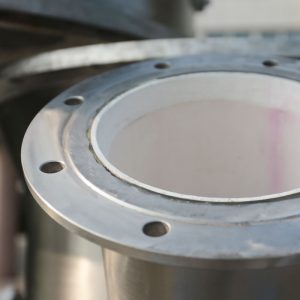
The fluidized bed jet mill that uses high-hardness engineering ceramics to make all flow-through parts is an ideal crushing equipment for high-hardness, brittle materials, elastic plastic materials, agglomerated materials, and fibrous materials, such as zircon, alumina, rutile titanium White powder, zirconia, talc, kaolin, graphite, paint, pesticide, fertilizer, pollen, food raw materials and other materials are crushed.
Ceramic-lined jet mill not only has the advantages of general fluidized bed jet mills, but also, because the machine's lining is made of high-strength, wear-resistant and high-temperature engineering ceramics, it can not only adapt to high temperature and overheating up to 400℃ The steam working medium does not pollute the material to be pulverized. It is a necessary equipment for high-quality ultra-fine pulverization. At the same time, the cost of airflow ultra-fine pulverization is mainly the cost of the pulverizing working medium, and the superheated steam working medium is higher than the compressed air working medium. The cost is reduced by a quarter. In addition, the superheated steam working fluid will not generate static electricity, so it will not cause wall sticking. Therefore, it is suitable for the production of some materials that will stick to the wall with compressed air at room temperature, such as: titanium dioxide .
The ceramic-lined jet mill is mainly composed of a feeding device, a crushing chamber, a discharge port, a steam distribution pipe and a nozzle. The material of the feed nozzle and the crushing nozzle is made of high-strength, wear-resistant and high-temperature-resistant special alloy, and the nozzle structure is supersonic design; the rest of the flow-through parts are lined with high-strength, wear-resistant and high-temperature engineering ceramics. The material venturi tube, ceramic middle ring, discharge port lining, ceramic upper cover and ceramic lower cover are made of high-strength reaction sintered silicon carbide; the steam distribution pipe and the main engine cover are all made of stainless steel and polished, and the whole machine has a beautiful appearance compact. The ceramic-lined jet mill can be used in conjunction with the jet classifier. According to the physical characteristics of the material and the purity requirements of the finished product, ceramic sheets are lined inside the equipment to increase wear resistance, reduce the impact of materials on the equipment, and increase the use of the equipment Life, and accurately control the iron content of the material in the crushing and grading process. Successfully solved a series of problems such as the adhesion of battery materials, poorly made, and inaccurate classification.
The working principle of the ceramic-lined jet mill: After being filtered and dried, compressed air is sprayed into the milling chamber at high speed through Laval nozzles, and the animal material is repeatedly collided and rubbed at the intersection of the high-pressure airflow to smash. The pulverized coarse and fine mixture is under negative pressure. The fan reaches the classification zone. Under the action of the strong centrifugal force generated by the high-speed rotating classification turbine, the coarse and fine materials are separated. The materials that meet the particle size requirements are collected by the cyclone separator and dust collector through the classification wheel, and the coarse particles drop to the crushing zone to continue. Shattered.
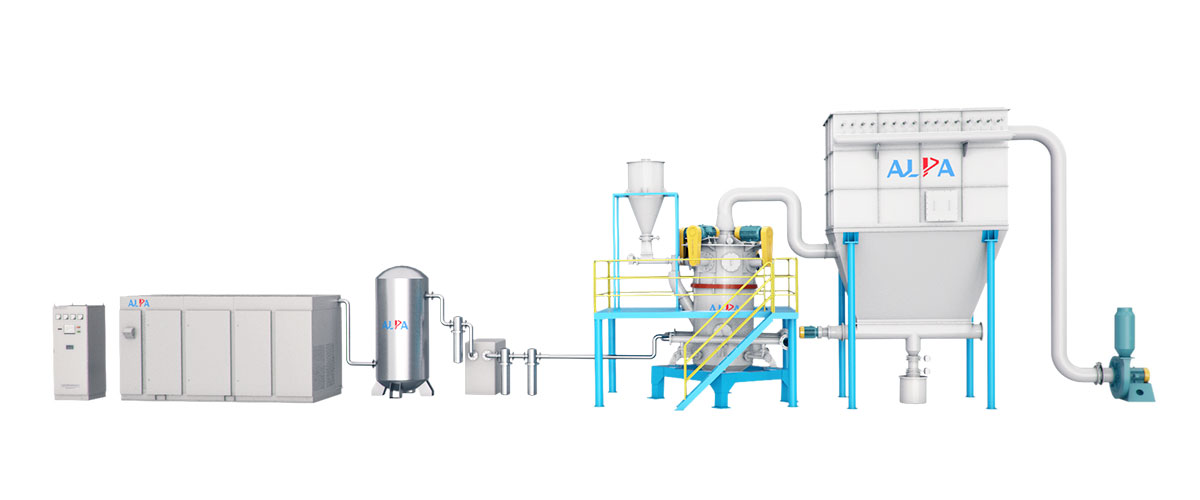
The ceramic-lined jet mill has the following performance advantages:
1. It is suitable for dry pulverization of various materials with Mohs hardness below 9, especially suitable for the pulverization of materials with high hardness, high purity and high added value.
2. The breakthrough of particle acceleration technology has greatly improved the pulverization efficiency and reduced the energy consumption. The pulverization is small, the particle shape is good, the particle size distribution is narrow and there are no large particles, and the product particle size D97=3-74 microns can be adjusted arbitrarily.
3. During the crushing process, the airflow temperature is reduced due to the rapid expansion of the airflow, which is especially suitable for the crushing of heat sensitive, low melting point and volatile materials.
4. The crushing of materials by collision with each other is different from the mechanical crushing which relies on the impact crushing of the materials such as blades or hammers, plus a full range of ceramic lining, so the equipment is less abraded and the product purity is high.
5. It can be used in series with a multi-stage air classifier to produce products with multiple particle sizes at one time.
6. The ceramic-lined jet mill has a compact structure, easy to disassemble and clean, and the inner wall is smooth and has no dead corners.
7. The entire system runs in a closed negative pressure, no dust, low noise, and the production process is clean and environmentally friendly.
8. The dust collector eliminates the problems of low negative pressure and sticking to the machine.
The difference between heavy calcium carbonate and light calcium carbonate
Calcium carbonate, commonly known as limestone, stone powder, marble, and calcite, is a compound with a chemical formula of CaCO3, which is alkaline and basically insoluble in water but soluble in acid. It is a common substance on the earth. It exists in aragonite, calcite, chalk, limestone, marble, travertine and other rocks, and is also the main component of animal bones or shells.
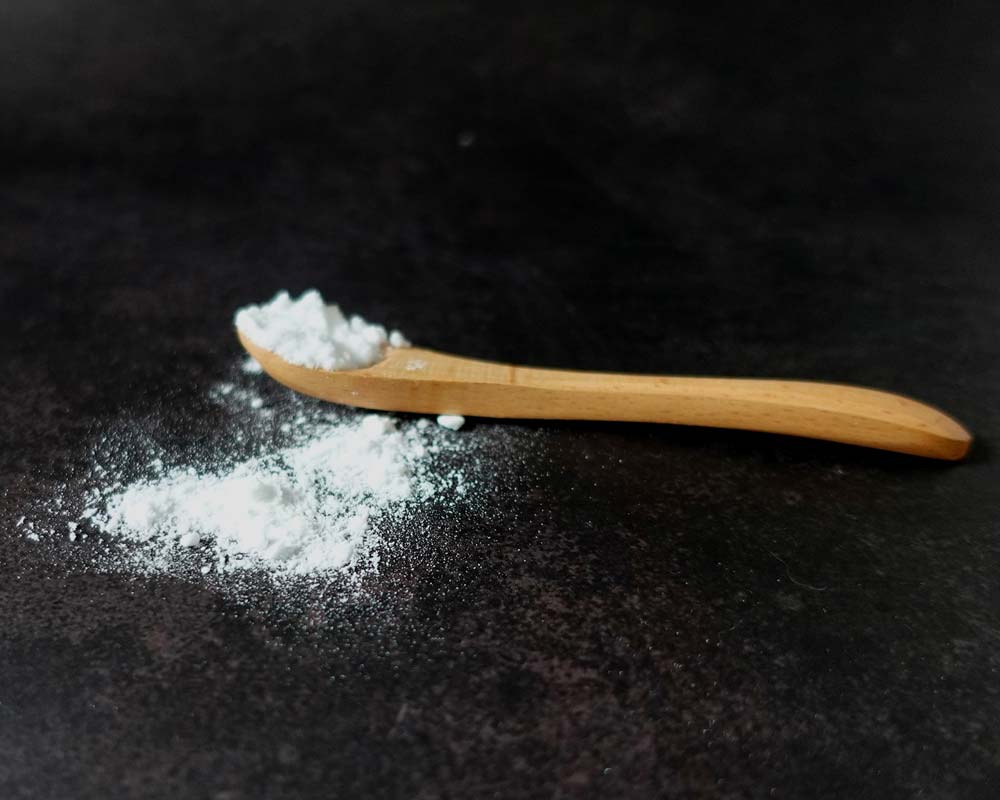
Heavy calcium carbonate and light calcium carbonate are classified according to different methods of calcium carbonate production. They can be distinguished from the following aspects:
1. Powder characteristics
The particles of heavy calcium carbonate are irregular in shape and are polydisperse powder. Its particle size is large, the average particle size is generally 5-10μm, and the distribution is wide. It is almost insoluble in water, soluble in water containing ammonium salt or ferric oxide, and insoluble in alcohol. It will boil and dissolve in dilute acetic acid, dilute hydrochloric acid, and dilute nitric acid. It is decomposed into calcium oxide (CaO) and carbon dioxide (CO2) when heated.
Light calcium carbonate particles have regular shapes and can be regarded as monodisperse powders, but they can be in various shapes, such as spindle, cubic, needle, chain, spherical, flake, and quadrangular prism. These different shapes of calcium carbonate can be prepared by controlling the reaction conditions. Its particle size is small, the average particle size is generally 1-3μm, and the distribution is narrow. It is hardly soluble in water and alcohol, soluble in acid, and emits carbon dioxide at the same time, showing an exothermic reaction. Also soluble in ammonium chloride solution. It is stable in the air and has a slight moisture absorption capacity.
Heavy calcium carbonate and light calcium carbonate are different in shape, particle size, etc. It is these differences that make them have different effects on physical and chemical properties and produce different effects.
2. Production process
The heavy calcium carbonate adopts the crushing method, and the white stone containing more than 90% CaCO3 is crushed, classified and separated with a Raymond mill or other high-pressure mill to obtain the finished product.
Light calcium carbonate adopts the carbonization method, which is the finished product is obtained by mixing limestone and white coal in a certain proportion, calcination at high temperature, water digestion, carbonization of carbon dioxide, centrifugal dehydration, drying, cooling, crushing and sieving.
The production process of light calcium carbonate is relatively complicated, and different production methods make them shine in different fields.
3. Purpose
Heavy calcium carbonate has a wide range of uses. It can be filled in rubber to obtain higher tensile strength, tear strength and abrasion resistance than pure rubber vulcanizates. It can play a role as a skeleton when used in plastic products, which has a great effect on the dimensional stability of plastic products, and can also increase the hardness of the products, and improve the surface gloss and surface smoothness of the products. It is used in the water-based coating industry to make the coating non-settling and easy to disperse. The heavy calcium carbonate used in papermaking can ensure the strength and whiteness of the paper, and the cost is low. Heavy calcium carbonate is used in concrete in the construction industry to play an important role, which can increase the toughness and strength of the product. It is used in the floor tile industry to increase the whiteness and tensile strength of the product, improve the toughness of the product, and reduce the production cost.
Light calcium carbonate can be used as a filler in industries such as rubber, plastics, papermaking, coatings and inks, and is widely used in the production of organic synthesis, metallurgy, glass and asbestos. It can also be used as a seeding agent for industrial wastewater, an antacid for gastric and duodenal ulcers, an antidote for acidosis, an SO2 scavenger in SO2-containing exhaust gas, an additive for dairy cattle feed, and an anti-sticking agent for linoleum. . It can also be used as a raw material for tooth powder, toothpaste and other cosmetics.
With the continuous advancement of powder technology, the application fields of calcium carbonate are constantly expanding, and they will also exert greater advantages in the future.
Article source: China Powder Network
Matters needing attention in safe operation of jet mill
Jet mills are becoming more and more popular in the powder industry, ranging from chemicals and mining to new energy sources, polymer materials, metals, superhard materials, medicines and foods, etc. Including rare earths, magnetic materials, ceramic materials, refractory materials, and light-emitting reflective materials all have applications in jet milling.
![]()
The following points should be paid attention to in the safe operation of jet mill:
1. Before starting the jet mill, check whether the various parts of the equipment are complete, and make sure that the parts are not loose, and the equipment can be started after confirming that it is correct.
2. The electric box and the motor must be grounded.
3. When the equipment is started, it is forbidden to touch any rotating parts, and it is forbidden to put your hands on the discharge port to prevent accidents or personal injury.
4. It is forbidden to do equipment maintenance and maintenance work under the condition of electrification and air.
Boot sequence:
1. Turn on the cooling water and start the air compressor. After 2-3 minutes of no-load operation, it is in normal operation.
2. Start the freeze dryer (the cooling water is connected with the cooling water of the air compressor).
3. The air compressor and freeze dryer work normally. After the air pressure reaches 0.7Mpa-1Mpa, start the host, adjust to the required speed, and then start the fan.
4. Before opening the main air pipe valve of the jet mill, adjust the air seal pressure of the motor bearing from 0.03Mpa to 0.05Mpa. After checking the above contents, start feeding and crushing.
5. Adjust the pulse air pressure of the dust collector to about 0.4Mpa.
6. When adjusting the thickness or fineness of the material according to the needs, the speed of the main machine's grading wheel can be adjusted: low coarse and high fine.
7. In the discharging process after crushing the material, tap the outer wall of the conveying pipe, cyclone and dust collector regularly with a leather hammer to avoid closing the contaminated material, causing the pipe to block and affecting the normal discharging.
Stop sequence (after stopping feeding):
1. Turn off the main air pipe valve. After the compressor is depressurized, turn off the air compressor power supply, turn off the freeze dryer, and then turn off the induced draft fan. When the rotation speed of the induced draft fan drops below half, turn off the inverter, turn off the dust collector, and turn off unloading. valve.
2. When the temperature of the air compressor is lower than about 60°C, turn off the cooling water.
3. Regarding pulse dust removal: When the jet mill is shut down after work every day, let the pulse meter work for 5-10 minutes to wash off the powder adsorbed on the filter bag and keep the air flow unblocked.
The main application areas of talc
Talc is a filler for plastics second only to calcium carbonate, and the number of applications in plastics is more than 200,000 tons per year. As some of the physical and chemical properties of talc have been further understood, its application scope and The number is increasing dramatically.

1) Use as a heat preservation agent for agricultural film
Silicon-containing minerals, such as mica, kaolin and talc, have a blocking and shielding effect on infrared rays. Adding an appropriate amount of this mineral powder to the agricultural greenhouse film can improve the resistance of the plastic film to infrared rays, thereby reducing the loss of heat in the shed to the outside of the shed in the form of infrared radiation at night, and improving the thermal insulation of the greenhouse.
The research results of the Light Industry Plastics Processing and Application Research Institute in the early 1990s show that:
①When mica powder, kaolin, talc powder and light calcium carbonate have the same filling amount (close in fineness and surface treatment), the mechanical properties of polyethylene film are close to each other, and the mechanical properties of the film filled with kaolin and mica powder are better. a little better.
②The barrier effect of LDPE film filled with silicon-containing fillers on 7-25μm infrared is significantly better than that of inorganic fillers without Si-light calcium carbonate, while the infrared barriers of mica powder, kaolin and talc are similar.
③ Among the three fillers containing Si, the light transmittance of LDPE film filled with mica powder is the highest, and is close to that of pure LDPE plastic film, followed by kaolin and talc, but both are higher than the film filled with calcium carbonate.
Because talc is cheap and easy to handle, although its light transmittance and infrared light barrier properties are not as good as mica powder and kaolin, it can still maintain better light transmittance while improving its thermal insulation. Therefore, it has been used in agricultural plastic shed films. It is widely used. At present, agricultural film production plants use 1%-6% of ultra-fine talcum powder according to different types of film (aging-resistant film, double-proof film, multi-functional film, etc.).
2) Use as a nucleating agent
Crystalline polymers such as polyethylene (PE), polypropylene (PP), polyethylene terephthalate (PET), polyamide (PA), etc., during the cooling and shaping process after melting, some macromolecules The arrangement is ordered, which is called crystallization.
Crystallization not only requires a certain temperature and cooling rate, but also requires the generation of crystal nuclei first, followed by crystal growth. The nucleating agent has two main functions. One is to increase the total crystallization rate, which can ensure that the molten polymer solidifies more quickly during the cooling process, thereby shortening the injection molding cycle cycle and improving work efficiency; Tensile strength, heat distortion temperature and hardness are all enhanced under the action of nucleating agent, transparency increases and turbidity decreases.
Talcum powder is used as a nucleating agent for PE or PP. First of all, the particles are required to be small. The smaller the particle size, the more the number of particles, which means the more crystal centers. The more crystals grown at the same time, the smaller the size of the crystal itself, and the better the performance of the entire material. At the same time, it is also required that the dispersion of the stone powder in the molten state is as thorough as possible, and the agglomeration phenomenon is as slight as possible.
3) Transparent filler masterbatch with talc as the main filler
Although the use of calcium carbonate in the plastic film can reduce the cost, when the amount is large, the transparency of the film is greatly affected, causing misunderstandings by some users. In response to this situation, the transparent filler masterbatch has made significant improvements in filler selection and processing technology, which greatly improved the transparency of the PE film.
Article source: China Powder Network
What problems should be paid attention to in powder surface modification
Powder surface modification refers to the use of physical, chemical, mechanical and other methods to treat the surface or interface of powder materials, and purposefully change the chemical properties of the surface of powder materials to meet the development of modern new materials, new processes and new technologies. need. It is a new technology that integrates powder processing, material processing, material properties, chemicals, and machinery.
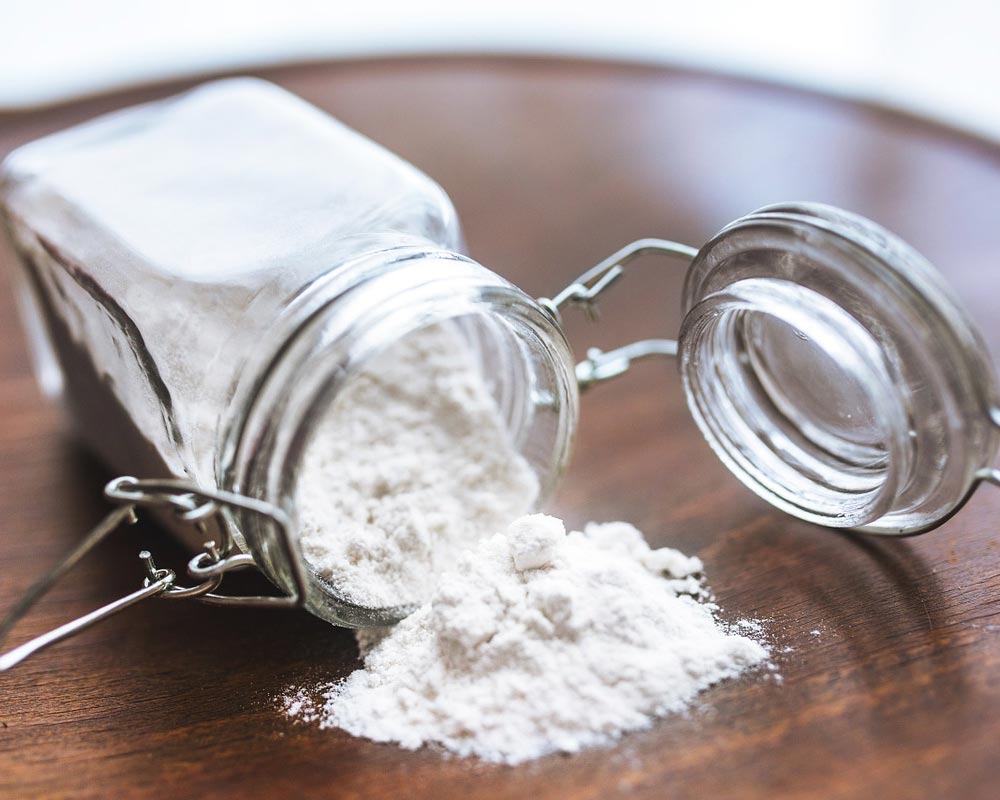
The following aspects should be paid attention to in the work of powder surface modification.
- The principle and method of powder surface modification
(1) The relationship between surface or interface properties and their application performance
(2) The mechanism and model of action between the surface or interface and the surface modifier or treatment agent
(3) The basic principles or theoretical basis of various surface modification methods, including the thermodynamics and kinetics of the surface modification process, simulation and chemical calculations, etc.
- Surface modifier and its formula
(1) The relationship between type, structure, molecular weight, active group and its application performance or function
(2) Mechanism and model of action with powder surface and composite materials
(3) Dosage and method of use
(4) Preparation or synthesis of new and special surface modifiers
- Surface modification process and equipment
(1) Process flow and process conditions for surface modification of powders of different types and uses
(2) Surface modification formulas of different types and different uses of powder
(3) Factors affecting the effect of surface modification
(4) Research and development of high-performance and special modified equipment
- Process control and product characterization and detection technology
(1) Monitoring technology such as process temperature, concentration, acidity, time and surface modifier dosage, surface coverage rate or coating thickness
(2) Characterization and detection (direct detection and characterization) methods and instruments of surface modified products;
(3) Correspondence between control parameters and indicators and intelligent control of the process.
Article source: China Powder Network
Mineral fillers and their role in coatings
Filler is also called filler, which is a type of material added to materials (such as plastic, rubber, paper, paint, etc.) for filling. It can reduce costs, improve performance, and improve process characteristics of materials.
Fillers can be divided into two types: one is to reduce costs by adding cheap materials to higher-priced materials and does not change the material properties of inert fillers; the other is functional fillers with special functions, such as electricity Insulating, conductive, magnetic, flame-retardant, anti-static and reinforcing, etc., the material properties can be improved after being added.
Classification of mineral fillers
Fillers have a wide range of applications, a wide variety of varieties, and a variety of classification methods. According to the material composition, it is divided into three categories: organic fillers and inorganic fillers, or mineral fillers, plant fillers, and synthetic fillers.
- Classified according to the geometric form of the filler
Particles are in the form of fillers, and the shape of the particles is not very regular, but the geometric shapes of different fillers have significant differences. The particle shape of different fillers has a significant impact on the performance of the product.
Morphological classification of mineral examples, particle geometry comparison
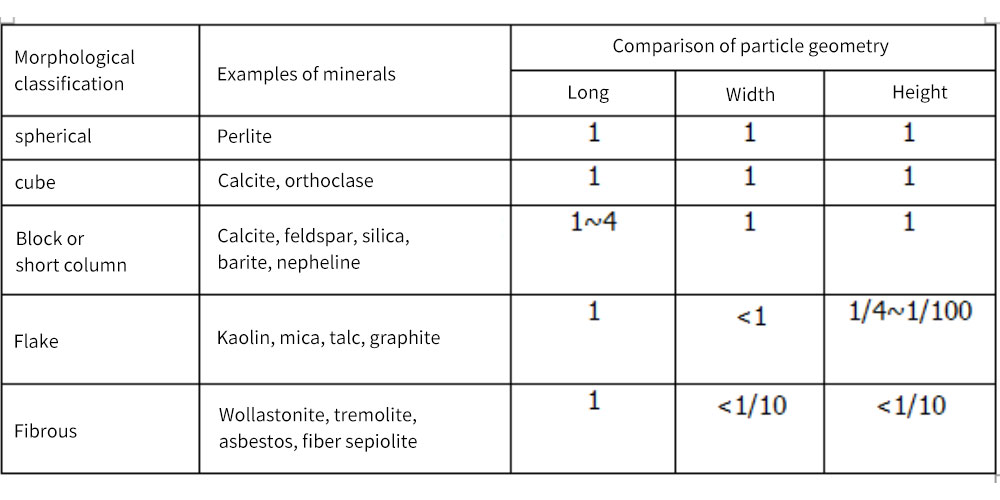
- Classified according to the chemical composition of the filler
In filler modification, the chemical composition of the filler determines the essence of the filler, especially when the material is given functionality, the chemical composition of the filler plays a decisive role. American scholar Hurlbut divides the chemical composition of fillers into four categories: oxide, salt, elemental substance and organic matter.
- Classified by filler application
There are many kinds of minerals that can be used as mineral fillers, and they have a wide range of uses. According to the application fields of fillers, they can be divided into more than 10 kinds of fillers such as plastic fillers, rubber fillers, paper fillers, paint fillers, and paint fillers.
The role of fillers in coatings:
1. Play the role of skeleton and filling in the paint, increase the thickness of the paint film, and make the paint film plump and solid.
2. It can adjust the rheological properties of the coating.
3. Improve the mechanical strength of the paint film, such as improving abrasion resistance and durability.
4. Adjust the optical properties of the coating and change the appearance of the coating film, such as matting.
5. The film-forming substance undergoes a chemical reaction to make it into a whole, so that the coating film can effectively block the penetration of light, improve its water resistance and weather resistance, and extend the service life of the coating film.
6. As a filler in coatings, it can reduce the amount of resin and reduce production costs.
7. It assists the chemical properties of the coating film, such as enhancing anti-rust, moisture resistance, flame retardancy, etc.
The oil absorption value (g/100g) of non-metallic mineral fillers commonly used in coatings.
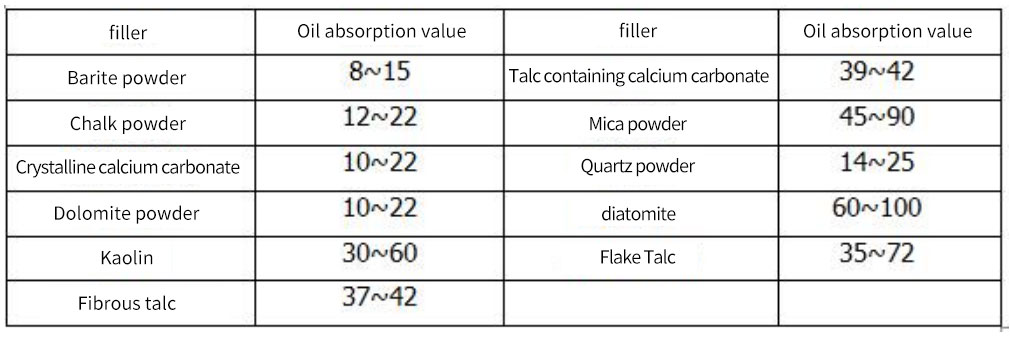
The fillers commonly used in coatings are calcium carbonate (heavy calcium, light calcium), barite powder (barium sulfate), talc powder, kaolin (porcelain soil), porous powdered quartz (silica), white carbon black, precipitated barium sulfate, Mica powder, wollastonite, bentonite, etc.
Calcium carbonate
Calcium carbonate is an important filler in paint production. Calcium carbonate plays the role of filling the framework and bottom plate (steel plate, wood) in the paint film, and enhances the deposition and permeability of the paint film.
Talcum powder
Talc is a universal filler in solvent-based coatings. It is currently used in various primers, intermediate coatings, road marking paints, industrial coatings and architectural coatings for internal and external use.
Kaolin
Kaolin is one of the fillers widely used in foreign coatings industry. Kaolin commonly used in coatings includes ultrafine kaolin, calcined kaolin, activated kaolin (surface modification treatment), etc. Kaolin can be used in various coatings, but mainly water-based architectural coatings.
Graphite
Natural graphite can be used in steel structure maintenance coatings due to its flake structure and good hiding rate. Its good conductivity and black color make it suitable for use in electronic and computer electrical shielding coatings. This coating can contain up to 75% graphite. Another use is anti-static floor coatings. It can be used in heat-resistant coatings, primers, sealing coatings and water-resistant coatings. Because of its good light resistance, it can be used in automotive paints as an effect pigment.
Wollastonite
The main component of wollastonite is calcium metasilicate (CaSiO3), which has a needle-like structure, good brightness, refractive index (1.62) and relatively low oil absorption (20~26g/100g)
Wollastonite with needle-like structure (length-to-diameter ratio is 10:1~20:1) can act as a smoothing agent in coatings, improve the mechanical strength of the coating film, and sometimes replace harmful asbestos in reinforced coatings. In coatings, it is generally used for relatively fine-grained (such as 325 mesh) and fine-grained (10μm) wollastonite powder, because it is beneficial to the hiding power of the coating. It can be used for oil-based architectural coatings, sound-absorbing (sound insulation) coatings, road marking paints, polyvinyl acetate latex paints, etc. Surface-treated wollastonite can be used in industrial alkyd, epoxy and other anti-corrosion coatings to improve the corrosion resistance of metal primers and partially replace active anti-rust pigments.
Article source: China Powder Network


